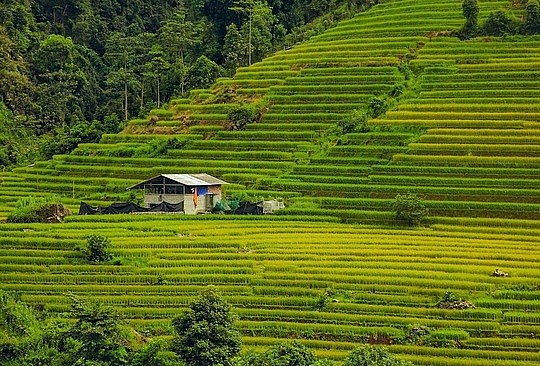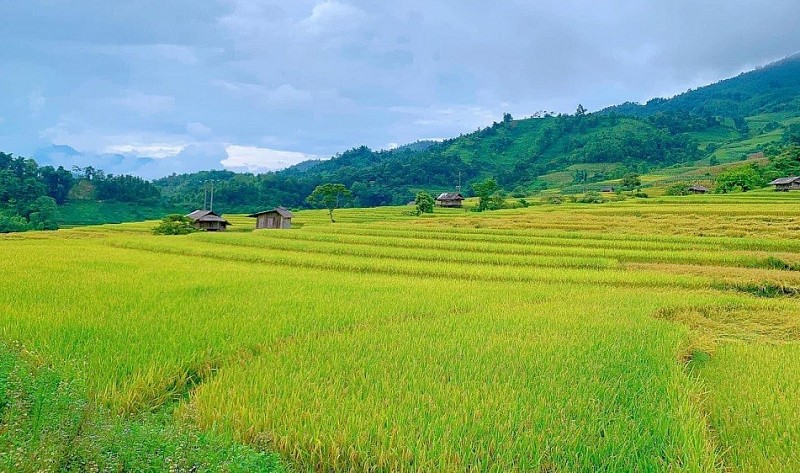
Sweet memories of Nam Cang
Latest
 |
| The terraced rice fields in Nam Cang are in the ripening season. (Photo: Hieu Phuong) |
Nam Cang is located in Lien Minh commune, Sa Pa town, Lao Cai province. From Sa Pa, visitors can take the inter-provincial road No.152 about 36km to Nam Cang.
In the local language, Nam Cang means watershed. This place generates the source of 3 large streams: namely Nam Cang, Nam Pa and Nam Thang (Nam means water), which provide clean water for people's daily lives as well as water for fertile fields.
Not as brilliant as Ta Phin or Muong Hoa and not as pulsating as a land of strong tourism development, Nam Cang has its own new tourist attraction. It is a green valley, surrounded by mountains and forests, so it is somewhat separate from the city and other regions. It is said to be a disguised "solitude" feature that has made the space here more peaceful and tranquil than anywhere else.
When it comes to Nam Cang, first of all, it is the long and wide terraced fields that catch the eyes of viewers. The fields overlap with other fields in endless panorama, winding like golden shallow waves, brighter in the sunlight. Far in the distance are glittering gently flowing streams, towering cliffs and pretty huts of local people, all of which creates a natural artistic picture.
More specifically, the rice here ripens earlier than in other places. In the middle of July, the dough stage of rice growth begins to form the grain. Mid-August and early September is the season of ripe rice. At this time, it seems that the whole village has changed its fashions to a bright yellow color and full of life.
Standing on a higher hill looking down, Nam Cang is in sight. It looks like a colorful picture. Interspersed between the stilt houses of the Hmong and Dao ethnic groups spread out the terraced fields in the ripen rice season.
Therefore, coming to Nam Cang in this season, in addition to admiring the peaceful natural beauty, visitors have the opportunity to enjoy mountain products with attractive food such as stewed horse meat, salmon hot pot, pork of small-sized pot-bellied pig (locally named tiny pig held in the armpits), grilled stream fish, roasted pork and many kinds of fragrant wild vegetables.
In the afternoon, it is enjoyable at one’s discretion to have a casual walk down to the villages and hamlets, to explore the life of the Red Dao ethnic people in the valley; learn about famous traditional embroidery, silver carving, bamboo paper making and herbal medicine preparation.
The trail weaves through the houses located in the middle of the deep forest, bringing visitors from one place of interest to another. The more we stay for exploration, the more we find that life here is serene: women are weaving, embroidering, or going to the forest to pick herbal leaves; men are busy with silver carving and farming; children roam around large and small streams or herds of buffaloes, cows, and help with household chores during days off school.
 |
| The terraced fields in Nam Cang spread in length and width. (Photo: VNE) |
After a long day of exploring and learning about the cultural beauty of the local people, visitors relax in pure water-filled wooden bath tubs with the light scent of various forest leaves. According to health care experts, bathing with medicinal leaves of the Dao people is not only a method of health care but also a factor forming the cultural identity of the local people.
In the past, the people in Nam Cang mainly lived by farming and animal husbandry and had the habit of going to the forest as well as living by the streams. They would go into the forest to pick herbal leaves to make medicine or find food…
However, now, the people of Nam Cang not only maintain terraced fields to create landscapes, but also know how to rely on the mountain position and enjoy the preferential natural beauty, preserving cultural identity, developing traditional handicrafts (brocade embroidery, silver carving, forging agricultural tools, knitting baskets...) to form an attractive tourist attraction in the Sapa Discovery Tour distinguishing itself with community tourism, and wellness tourism.
In tandem with tourism development, the people have been strongly expanding the cold-water aquaculture with more than 80 fish farms along Nam Than stream and some small streams. Many families collect dozens of tons of fish each nesting season.
According to the Secretary of the Party Committee of Lien Minh Commune – Mr. Vu A Trung who reveals that there are about 80 cold-water fish farms in the villages of the old Nam Cang commune. Every house has 2-3 tanks at least; many houses have a system of dozens of fish tanks.
The largest and longest fish-farming householder in Nam Cang is Mr. Tan Chan Quyen. Not only is he a pioneer in bringing cold-water fish species for aquaculture, he also invites a fisheries expert to manage the incubation of fingerlings and commercial fish and pay a remuneration of VND 15 million per month.
It is like an unfinished excursion if we fail trekking to explore the big streams, enjoy the fresh, green air inside the dense forests and admire the majestic Northwest mountain scenery in Nam Cang.













